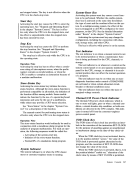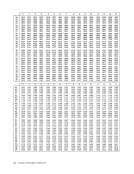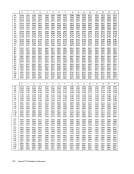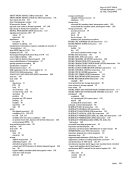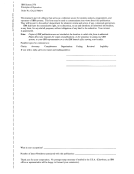13
14
15
16-23
24-25
and the success or failure of transmission
through previous check stations.
Normally, only one bit will be present in
this field. However, when inter-unit com
munication cannot be resolved to a single
unit, such as when the interface between
units is at fault, multiple bits (normally two)
may be set in this field. When a reasonable
determination cannot be made, all bits in
this field are set to zero.
If the detect and source fields indicate dif
ferent units, the interface between them can
also be considered suspect.
Bit 8 --CPU Bit 9 --Channel
Bit10 -- Main storage control
Bit 11 --Main storage
Bit 12 --Control unit
Reserved. Stored zero.
Reserved. Stored zero.
Reserved. Stored zero.
Field validity flags. These bits indicate the
validity of the information stored in the des
ignated fields. When the designated field is
stored by the channel with the correct con
tents, the validity bit is one. When the des
ignated field is stored by the channel with
unpredictable contents, the validity bit is
zero. The validity bits for nonstored fields
are meaningless.
The fields designated are:
Bit 16 --Interface address
Bit 17 --(Reserved. Stored zero)
Bit 18 --(Reserved. Stored zero)
Bit 19 --Sequence code
Bit20 -- Unit status
Bit 21 --Command address and key
Bit 22 --Channel address
Bit 23 --Device address
Type of termination that has occurred is
indicated by these two bits.
This encoded field has meaning only
when a channel control check or an inter
face control check is indicated in theCSW. When neither of these two checks is indicat
ed, no termination has been forced by the
channel.00 Interface disconnect 01 Stop, stack, or normal termination 10 Selective reset
11 System reset
26-27
28
29-31
Reserved. Stored zero.I/O error alert. This bit, when set to one,
indicates that the limited channel logout re
sulted from the signaling ofI/O error alert
on theI/O interface by the indicated unit.
TheI/O error alert signal indicates that the
control unit has detected a malfunction
which prevents it from communicating prop
erly with the channel. The channel, in re
sponse, performs a malfunction reset and
causes interface control check to be set.
Sequence code identifies theI/O sequence
in progress at the time of error. It is mean
ingless if stored during the execution of
HALTI/O or HALT DEVICE.
For all cases, the channel program ad
dress, if validly stored and if nonzero, is the
address of the current CCW + 8.
The sequence code assignments are:000 A channel-detected error occurred
during the execution of aTEST I/O or
CLEARI/O instruction. 001 Command-out with a nonzero com
mand byte on bus-out has been sent
by the channel, but device status has
not yet been analyzed by the channel.
This code is set with a command-out
response to address-in during initial
selection.010 The command has been accepted by
the device, but no data has been trans
ferred. This code is set by a service
out or command-out response to
status-in during an initial selection se
quence, if the status is either channel
end alone, or channel end and device
end, or channel end, device end, and
status modifier, or all zeros.011 At least one byte of data has been
transferred over the interface. This
code is set with a service-out response
to service-in and, when appropriate,
may be used when the channel is in an
idle or polling state.100 The command in the current CCW has
either not yet been sent to the device
or else was sent but not accepted by
the device. This code is set when one
of the following conditions occurs:
1. When the command address is
updated during command chain
ing or aSTART I/O. Input/Output Operations 241
14
15
16-23
24-25
and the success or failure of transmission
through previous check stations.
Normally, only one bit will be present in
this field. However, when inter-unit com
munication cannot be resolved to a single
unit, such as when the interface between
units is at fault, multiple bits (normally two)
may be set in this field. When a reasonable
determination cannot be made, all bits in
this field are set to zero.
If the detect and source fields indicate dif
ferent units, the interface between them can
also be considered suspect.
Bit 8 --
Bit
Bit 11 --Main storage
Bit 12 --Control unit
Reserved. Stored zero.
Reserved. Stored zero.
Reserved. Stored zero.
Field validity flags. These bits indicate the
validity of the information stored in the des
ignated fields. When the designated field is
stored by the channel with the correct con
tents, the validity bit is one. When the des
ignated field is stored by the channel with
unpredictable contents, the validity bit is
zero. The validity bits for nonstored fields
are meaningless.
The fields designated are:
Bit 16 --Interface address
Bit 17 --(Reserved. Stored zero)
Bit 18 --(Reserved. Stored zero)
Bit 19 --Sequence code
Bit
Bit 21 --Command address and key
Bit 22 --Channel address
Bit 23 --Device address
Type of termination that has occurred is
indicated by these two bits.
This encoded field has meaning only
when a channel control check or an inter
face control check is indicated in the
ed, no termination has been forced by the
channel.
11 System reset
26-27
28
29-31
Reserved. Stored zero.
indicates that the limited channel logout re
sulted from the signaling of
on the
The
control unit has detected a malfunction
which prevents it from communicating prop
erly with the channel. The channel, in re
sponse, performs a malfunction reset and
causes interface control check to be set.
Sequence code identifies the
in progress at the time of error. It is mean
ingless if stored during the execution of
HALT
For all cases, the channel program ad
dress, if validly stored and if nonzero, is the
address of the current CCW + 8.
The sequence code assignments are:
during the execution of a
CLEAR
mand byte on bus-out has been sent
by the channel, but device status has
not yet been analyzed by the channel.
This code is set with a command-out
response to address-in during initial
selection.
the device, but no data has been trans
ferred. This code is set by a service
out or command-out response to
status-in during an initial selection se
quence, if the status is either channel
end alone, or channel end and device
end, or channel end, device end, and
status modifier, or all zeros.
transferred over the interface. This
code is set with a service-out response
to service-in and, when appropriate,
may be used when the channel is in an
idle or polling state.
either not yet been sent to the device
or else was sent but not accepted by
the device. This code is set when one
of the following conditions occurs:
1. When the command address is
updated during command chain
ing or a
























































































































































































































































